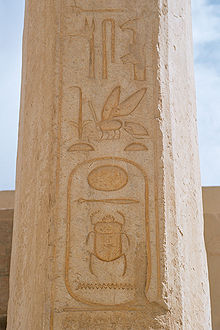The royal titulary or royal protocol of an Egyptian pharaoh is the standard naming convention taken by the kings of Ancient Egypt. It symbolises worldly power and holy might and also acts as a sort of mission statement for the reign of a monarch (sometimes it even changed during the reign).
The full titulary, consisting of five names, did not come into standard usage until the Middle Kingdom but remained in use as late as the Roman Empire.
Horus name
The Horus name is the oldest form of the pharaoh's name, originating in the Predynastic Period. Many of the oldest-known Egyptian pharaohs were known only by this title.[1]
The Horus name was usually written in a serekh, a representation of a palace façade. The name of the pharaoh was written in hieroglyphsinside this representation of a palace. Typically an image of the falcon God Horus was perched on top of or beside it.[1]
At least one Egyptian ruler, the 2nd dynasty Seth-Peribsen, used an image of the god Seth instead of Horus, perhaps signifying an internal religious division within the country. He was succeeded by Khasekhemwy, who placed the symbols of both Seth and Horus above his name. Thereafter, the image of Horus always appeared alongside the name of the pharaoh.[1]
By the time of the New Kingdom the Horus name was often written without the enclosing serekh.
Nebty ("two ladies") name
The Nebty name (lit. "two ladies") was associated with the so-called "heraldic" goddesses of Upper and Lower Egypt:
- Nekhbet, patron deity of Upper Egypt, represented by a vulture, and
- Wadjet, patron deity of Lower Egypt, represented by a cobra.
The name is first definitively used by the First Dynasty pharaoh Semerkhet, though it only became a fully independent title by the Twelfth Dynasty.
This particular name was not typically framed by a cartouche or serekh, but always begins with the hieroglyphs of a vulture and cobra resting upon two baskets, the dual noun "nebty".
Horus of Gold
Also known as the Golden Horus Name, this form of the pharaoh's name typically featured the image of a Horus falcon perched above or beside the hieroglyph for gold.
The meaning of this particular title has been disputed. One belief is that it represents the triumph of Horus over his uncle Seth, as the symbol for gold can be taken to mean that Horus was "superior to his foes". Gold also was strongly associated in the ancient Egyptian mind with eternity, so this may have been intended to convey the pharaoh's eternal Horus name.
Similar to the Nebty name, this particular name typically was not framed by a cartouche or serekh.
Throne name (prenomen)
The pharaoh's throne name, the first of the two names written inside a cartouche, and usually accompanied the title nsw-bity (nesu-bity, nesw-bit, nswt-bjtj). The term literally means "S/He of the Sedge and Bee", but is often translated for convenience as "King of Upper and of Lower Egypt", the sedge and bee being symbols for Upper and Lower Egypt, respectively.[2]
The term nsw-bity It has been suggested that the Berber term for "strong man; ruler" might be derived from it (Schneider 1993).
The epithet nb t3wy, "Lord of the Two Lands", referring to valley and delta regions of Egypt, often occurs as well.
Personal name (nomen)
This was the name given at birth. The name itself was preceded by the title "Son of Ra", written with the hieroglyph of a duck (za), a homonym for the word meaning "son" (za), adjacent to an image of the sun, a hieroglyph for the chief solar deity Ra. It was first introduced to the set of royal titles in the Fourth Dynasty and emphasizes the king's role as a representative of the solar god Ra. For women who became pharaoh, the preceding title was interpreted as "daughter" also.
Modern historians typically refer to the ancient kings of Egypt by this name, adding ordinals (e.g. "II", "III") to distinguish between different individuals bearing the same name.
Examples of the full titulary
Senusret I
In the Middle Kingdom, the full titulary was sometimes written in a single cartouche, as in this example from Senusret I, from Beni Hasan.
Hatshepsut
The full titulary of Eighteenth Dynasty pharaoh Hatshepsut, providing a guide to pronunciation and its equivalent meaning and showing the differences since this pharaoh is a woman, is as follows,
- Horus name: Wesretkau, "Mighty of Kas"
- Nebty name: Wadjrenput, "She of the Two Ladies, Flourishing of years"
- Golden Horus: Netjeretkhau, "Divine of appearance" (Netjeret is the feminine form of netery meaning 'godly' or 'divine', and khau, 'appearances')
- Praenomen: Maatkare, "Truth [Ma'at] is the Ka of Re"
- Nomen: Khnumt-Amun Hatshepsut, "Joined with Amun, Foremost of Noble Ladies"
Thutmose III
| |||||||||||||||||||||||||||||||||||||||||||||||||||||||||||||||||||||||||||||||||||
Thutmose III in hieroglyphs |
|---|
The full titulary of Eighteenth Dynasty pharaoh Thutmose III, providing a guide to pronunciation and its equivalent meaning, is as follows
- Horus name: Kanakht Khaemwaset, "Horus Mighty Bull, Arising in Thebes"
- Nebty name: Wahnesytmireempet, "He of the Two Ladies, Enduring in kingship like Re in heaven"
- Golden Horus: Sekhempahtydjeserkhaw, "Horus of Gold Powerful of strength, Sacred of appearance"
- Praenomen: Menkheperre, "He of the Sedge and the Bee, Enduring of form is Re"
- Nomen: Thutmose Neferkheperu, "Son of Ra, Thutmose, beautiful of forms"





No comments:
Post a Comment